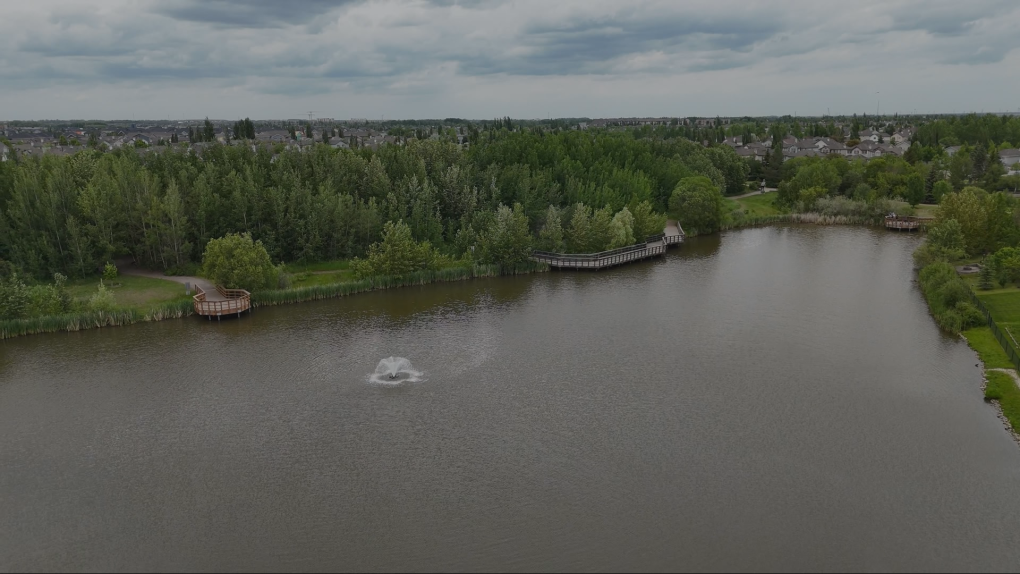Residents raise concerns over use of chemical in stormwater ponds to combat invasive goldfish
Residents of a west Edmonton neighbourhood are calling into question the use of a pesticide called harmless to humans by the utility that manages the city's stormwater facilities.
Epcor manages Edmonton's drainage system, including bodies of water such as a stormwater management facility in the neighbourhood of Glastonbury, where it has been using a broad-spectrum pesticide to kill invasive species of fish, specifically goldfish.
The utility informed residents in Glastonbury — which sits west of Anthony Henday Drive and south of Whitemud Drive — it has hired a contractor to fence off the pond in Guinevere Park and treat the water with a chemical treatment including rotenone, which Epcor says has been used successfully over the last five years.
The province requires Epcor to keep stormwater facilities free from invasive species such as goldfish to prevent spread to waterways such as the North Saskatchewan River.
In literature sent to people living in Glastonbury, Epcor called rotenone "not harmful to humans," a claim some residents say is false.
John O'Connor told CTV News Edmonton he is "sort of jarred" by the claim.
"It didn't take much research to find out that it definitely is harmful and has been banned in many jurisdictions and restricted in others," he said on Tuesday.
O'Connor said, "after some digging," he and others also found out Epcor would be using a solution of hydrocarbons he says are carcinogenic.
"In the U.S., those are on a right-to-know, hazardous substance list, so if you are going to experience this in your neighborhood, you have to be called beforehand in the U.S.," he said.
 A stormwater pond in the west Edmonton neighbourhood of Glastonbury. (CTV News Edmonton)Angus Grant, the senior manager of wastewater collection operations for Epcor, said the application of rotenone — which has been approved by Health Canada for the control of invasive species such as goldfish — is done "in accordance with the label rates."
A stormwater pond in the west Edmonton neighbourhood of Glastonbury. (CTV News Edmonton)Angus Grant, the senior manager of wastewater collection operations for Epcor, said the application of rotenone — which has been approved by Health Canada for the control of invasive species such as goldfish — is done "in accordance with the label rates."
"At those rates, they have been identified by Health Canada to be safe," he told CTV News Edmonton on Tuesday.
Grant said workers applying the solution to the water are wearing personal protective equipment in accordance with regulations and dilute chemicals down from concentrate before using it.
He said Alberta Environment and Protected Areas has been communicating with residents over several months and will continue to listen to their concerns about the process, adding that the application of the solution including rotenone is "not normal, everyday practice."
"We only intervene in these circumstances when it's absolutely required," he said.
Rotenone has been used in other places across Canada, including St. Albert in 2017 and 2018, to cull goldfish and other invasive species.
Melissa Logan, the City of St. Albert's environmental coordinator for the Sturgeon River and natural areas, says an extensive communication plan for residents on the impact of rotenone before its use in three stormwater facilities there helped alleviate concerns.
"We worked closely with Alberta Environment and Parks to ensure the information about the rotenone and the impacts of that were well-communicated and very clear," Logan told CTV News Edmonton on Tuesday, adding the impacts of rotenone are generally short-term.
"I think the success of our efforts were fully based around that communication (with) our residents."
With files from CTV News Edmonton's Nicole Weisberg and Kerry McAthey
Correction
A previous version of this story identified the neighbourhood as Keswick instead of Glastonbury. Keswick previously had its stormwater management facilities treated for invasive species.
CTVNews.ca Top Stories

Bird flu, measles top 2025 concerns for Canada's chief public health officer
As we enter 2025, Dr. Theresa Tam has her eye on H5N1 bird flu, an emerging virus that had its first human case in Canada this year.
DEVELOPING Body found in wheel well of plane at Maui airport
A person was found dead in the wheel well of a United Airlines flight to Maui on Tuesday.
Raised in Sask. after his family fled Hungary, this man spent decades spying on communists for the RCMP
As a Communist Party member in Calgary in the early 1940s, Frank Hadesbeck performed clerical work at the party office, printed leaflets and sold books.
Police identify victim of Christmas Day homicide in Hintonburg, charge suspect
The Ottawa Police Service says the victim who has been killed on Christmas Day in Hintonburg has been identified.
Christmas shooting at Phoenix airport leaves 3 people wounded
Police are investigating a Christmas shooting at Sky Harbor Airport in Phoenix that left three people injured by gunfire.
Ship remains stalled on St-Lawrence River north of Montreal
A ship that lost power on the St. Lawrence River on Christmas Eve, remains stationary north of Montreal.
Your kid is spending too much time on their phone. Here's what to do about it
Wondering what your teen is up to when you're not around? They are likely on YouTube, TikTok, Instagram or Snapchat, according to a new report.
Bird flu kills more than half the big cats at a Washington sanctuary
Bird flu has been on the rise in Washington state and one sanctuary was hit hard: 20 big cats – more than half of the facility’s population – died over the course of weeks.
6,000 inmates stage Christmas Day escape from high-security Mozambique prison
At least 6,000 inmates escaped from a high-security prison in Mozambique's capital on Christmas Day after a rebellion, the country's police chief said, as widespread post-election riots and violence continue to engulf the country.



























